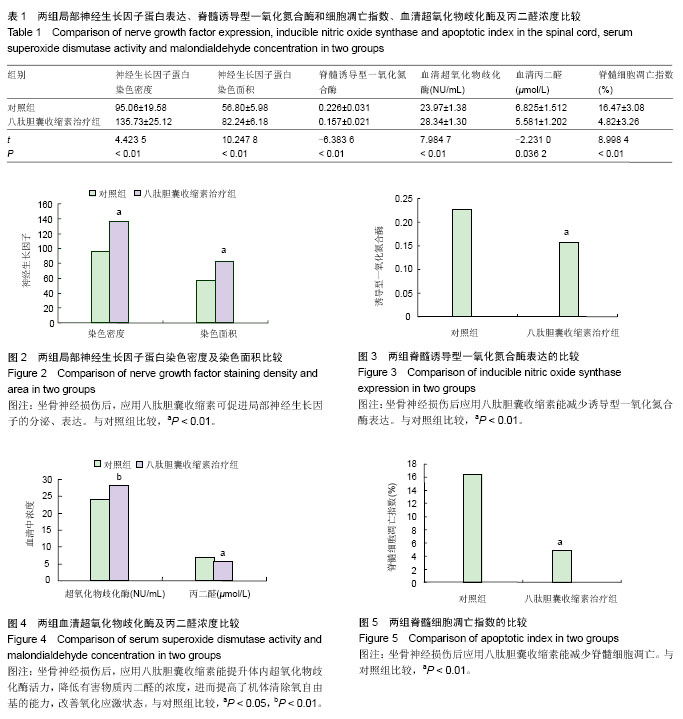| [1] 杨世方,凌亦凌,段国辰.胆囊收缩素与神经保护[J].中国病理生理杂志,2003,19(1):134-138.[2] 陈兴旺,孙晓江. 胆囊收缩素与神经细胞老化[J].中国老年学杂志,2005,25(3):356-358.[3] 崔轶霞,王海军,魏晓萍. 胆囊收缩素与胃肠道运动的研究进展[J].延安大学学报:医学科学版, 2004,2(3):62-63.[4] 杨蓬勃,王唯析,张建水,等. Meynert核毁损大鼠海马结构内胆囊收缩素阳性神经元的变化[J].西安交通大学学报:医学版. 2007, 28(1): 6-9.[5] Cope DW, Maccaferri G, Márton LF,et al. Cholecystokinin-immunopositive basket and Schaffer collateral-associated interneurones target different domains of pyramidal cells in the CA1 area of the rat hippocampus. Neuroscience. 2002;109(1):63-80.[6] 李娟,王丽,刘晓燕,等. 八肽胆囊收缩素对新生小鼠大脑皮层神经元生长的影响[J].泸州医学院学报,2011,34(1):13-15,19.[7] Sun XJ, Lu QC, Cai Y.Effect of cholecystokinin on experimental neuronal aging.World J Gastroenterol. 2005;11(4):551-556.[8] 孙红梅,曹榕娟,郭长青,等. 针刀松解与电针疗法对第3腰椎横突综合征模型大鼠下丘脑神经元型一氧化氮合酶、八肽胆囊收缩素表达的影响[J].解剖学杂志,2010,33(6):757-760,855.[9] 刘瑛,周江堡,肖农. 胆囊收缩素与神经生长因子的相关性[J]. 国外医学:神经病学神经外科学分册,2005,32(2):149-152.[10] Tirassa P, Aloe L,Stenfors C,et al.Cholecystokinin-8 protects central cholinergic neurons against fimbria–fornix lesion through the up-regulation of nerve growth factor synthesis. Proc Natl Acad Sci U S A. 1999; 96(11): 6473-6477.[11] Tirassa P, Stenfors C, Lundeberg T, et al. Cholecystokinin-8 regulation of NGF concentrations in adult mouse brain through a mechanism involving CCK(A) and CCK(B) receptors.Br J Pharmacol. 1998; 123(6):1230-1236.[12] 刘丽丽,周江堡. 八肽胆囊收缩素对周围神经元损伤的保护作用[J].国际神经病学神经外科学杂志,2008,35(6):481-485.[13] 陈宣煌,吴献伟,张国栋,等.胆囊收缩素促大鼠坐骨神经再生的初步研究[J].中华临床医师杂志(电子版),2011,5(24): 7242-7247.[14] 陈宣煌,郑祖高,占鲤生,等.胆囊收缩素对大鼠坐骨神经损伤后修复的影响[J].南昌大学学报(医学版),2012,52(7):4-7.[15] 陈宣煌,郑祖高,占鲤生,等.胆囊收缩素促大鼠坐骨神经再生的电生理检测及意义[J].海南医学院学报,2012,18(7): 869-871,874.[16] Miki T, Lehmann T, Cai H,et al.Stem cell characteristics of amniotic epithelial cells.Stem Cells. 2005;23(10):1549-1559.[17] Izumi M, Pazin BJ, Minervini CF,et al.Quantitative comparison of stem cell marker-positive cells in fetal and term human amnion.J Reprod Immunol. 2009;81(1):39-43.[18] Miki T, Marongiu F, Ellis EC,et al.Production of hepatocyte-like cells from human amnion.Methods Mol Biol. 2009;481:155-168.[19] Ilancheran S, Michalska A, Peh G,et al.Stem cells derived from human fetal membranes display multilineage differentiation potential.Biol Reprod. 2007;77(3):577-588.[20] Aloe L.Rita Levi-Montalcini: the discovery of nerve growth factor and modern neurobiology.Trends Cell Biol. 2004;14(7): 395-399.[21] Aloe L.Rita Levi-Montalcini and the discovery of NGF, the first nerve cell growth factor.Arch Ital Biol. 2011;149(2):175-181.[22] Chaldakov G.The metabotrophic NGF and BDNF: an emerging concept.Arch Ital Biol. 2011;149(2):257-263.[23] Pradat PF.Treatment of peripheral neuropathies with neutrotrophic factors: animal models and clinical trials.Rev Neurol (Paris). 2003;159(2):147-161.[24] Apfel SC, Kessler JA.Neurotrophic factors in the treatment of peripheral neuropathy.Ciba Found Symp. 1996;196:98-108; discussion 108-112.[25] Semkova I, Krieglstein J.Neuroprotection mediated via neurotrophic factors and induction of neurotrophic factors.Brain Res Brain Res Rev. 1999;30(2):176-188.[26] Sen D, Huchital M, Chen YL.Crosstalk between delta opioid receptor and nerve growth factor signaling modulates neuroprotection and differentiation in rodent cell models.Int J Mol Sci. 2013;14(10):21114-21139.[27] Culmsee C, Semkova I, Krieglstein J.NGF mediates the neuroprotective effect of the beta2-adrenoceptor agonist clenbuterol in vitro and in vivo: evidence from an NGF-antisense study.Neurochem Int. 1999;35(1):47-57.[28] 章丹丹,刘俊,Ferid Murad,等.诱导型一氧化氮合酶与疾病[J].现代生物医学进展,2007,7(10):1571-1573,1577.[29] Guzik TJ, Korbut R, Adamek-Guzik T.Nitric oxide and superoxide in inflammation and immune regulation.J Physiol Pharmacol. 2003;54(4):469-487.[30] Semenza GL, Wang GL.A nuclear factor induced by hypoxia via de novo protein synthesis binds to the human erythropoietin gene enhancer at a site required for transcriptional activation.Mol Cell Biol. 1992;12(12): 5447-5454.[31] Huang LE, Ho V, Arany Z,et al.Erythropoietin gene regulation depends on heme-dependent oxygen sensing and assembly of interacting transcription factors.Kidney Int. 1997;51(2): 548-552.[32] Marchetti B, Serra PA, Tirolo C, et al.Glucocorticoid receptor-nitric oxide crosstalk and vulnerability to experimental parkinsonism: pivotal role for glia-neuron interactions.Brain Res Brain Res Rev. 2005;48(2):302-321.[33] Godínez-Rubí M, Rojas-Mayorquín AE, Ortuño-Sahagún D.Nitric oxide donors as neuroprotective agents after an ischemic stroke-related inflammatory reaction.Oxid Med Cell Longev. 2013;2013:297357.[34] Amin AR, Attur M, Abramson SB.Nitric oxide synthase and cyclooxygenases: distribution, regulation, and intervention in arthritis.Curr Opin Rheumatol. 1999;11(3):202-209.[35] Levy D, Höke A, Zochodne DW.Local expression of inducible nitric oxide synthase in an animal model of neuropathic pain.Neurosci Lett. 1999;260(3):207-209.[36] De Alba J, Clayton NM, Collins SD, et al.GW274150, a novel and highly selective inhibitor of the inducible isoform of nitric oxide synthase (iNOS), shows analgesic effects in rat models of inflammatory and neuropathic pain.Pain. 2006;120(1-2): 170-181.[37] Hesslinger C, Strub A, Boer R,et al.Inhibition of inducible nitric oxide synthase in respiratory diseases.Biochem Soc Trans. 2009;37(Pt 4):886-891.[38] Lin H, Hou C, Chen D.Altered expression of inducible nitric oxide synthase after sciatic nerve injury in rat.Cell Biochem Biophys. 2011;61(2):261-265.[39] Lin HD, Wang H, Chen DS,et al.Effect of extract of Ginkgo biloba leaves on expression of inducible nitric oxide synthase after sciatic nerve injury: experiment with rats.Zhonghua Yi Xue Za Zhi. 2007;87(7):485-488.[40] Cui Z, Lv Q, Yan M,et al.Elevated expression of CAPON and neuronal nitric oxide synthase in the sciatic nerve of rats following constriction injury.Vet J. 2011;187(3):374-380.[41] Liu XH, Kato H, Nakata N,et al.An immunohistochemical study of copper/zinc superoxide dismutase and manganese superoxide dismutase in rat hippocampus after transient cerebral ischemia.Brain Res. 1993;625(1):29-37.[42] Barreto G, White RE, Ouyang Y,et al.Astrocytes: targets for neuroprotection in stroke.Cent Nerv Syst Agents Med Chem. 2011;11(2):164-173.[43] Barreto GE, Gonzalez J, Torres Y, et al.Astrocytic-neuronal crosstalk: implications for neuroprotection from brain injury. Neurosci Res. 2011;71(2):107-113. |


.jpg)